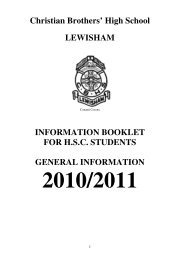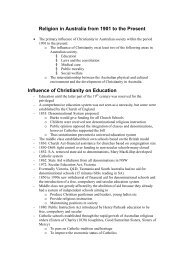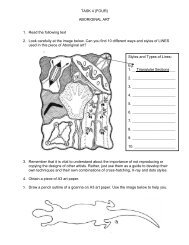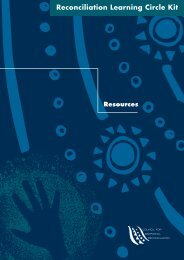THE NAZI TREATMENT OF MINORITIES The following workpack ...
THE NAZI TREATMENT OF MINORITIES The following workpack ...
THE NAZI TREATMENT OF MINORITIES The following workpack ...
Create successful ePaper yourself
Turn your PDF publications into a flip-book with our unique Google optimized e-Paper software.
<strong>THE</strong> <strong>NAZI</strong> <strong>TREATMENT</strong> <strong>OF</strong> <strong>MINORITIES</strong><strong>The</strong> <strong>following</strong> <strong>workpack</strong> was produced by students at Wolverhampton Grammar School,England. Each student researched a different area and came up with suitable tasks anddiscussion points based on their findings.Each set of notes can be used as a stand-alone worksheet, or the whole pack can beused to complete a table like the one on the <strong>following</strong> page.Following completion of the table, it is a good idea to discuss the issues it raises, forexample:• What would your criteria be for determining(a) Guilt at a war crimes trial(b) Whether someone should be granted asylum in the UK?• How would you summarise the role played by German people with regard to Nazitreatment of minorities (TIP: did their role change over time? Does it depend on theparticular group of ‘undesirables’ being persecuted? Did the Nazis merely amplifyexisting prejudices, or generate new ones?)• Compare and contrast the role played by the <strong>following</strong> groups with regard to thepersecution of minorities in Nazi Germany:(a) Hitler himself(b) <strong>The</strong> Nazi State(c) <strong>The</strong> German people• Were Nazi policies towards minorities motivated most by (a) ideological or (b)pragmatic considerations?• In what ways did Nazi policies towards various groups follow a similar pattern?• What impact did the war have on Nazi policies?• What is the best way of preventing these sorts of policies from ever happening again?Explain your answer carefully with some constructive suggestions.
three extermination camps of Aktion Reinhardt. <strong>The</strong> T4 operation members Wirth, Stangl and Eberlbecame the first commanders of Belzec, Sobibor and Treblinka Concentration camps. Wirth wasappointed inspector of the Einsatz Reinhardt extermination camps.Conclusion• By 1945: <strong>The</strong> "mercy killing" of people "not worth living" had become a murderous programme in NaziGermany resulting in the killing of nearly 280,000 innocent people. <strong>The</strong>y were killed by starvation, lethalinjection or by gas in mobile vans called “killer boxes” or gas chambers disguised as shower baths.Relatives were sent letters informing them of death by measles or “general weakness” and an urn ofashes. However, a lot of the time the wrong urns were sent so relatives of boys would get hair clips in theurn. Administrative errors were common and so mistakes like saying someone died from appendicitiswhen they’d already had their appendix removed aroused suspicion. <strong>The</strong> euthanasia programmecontributed in several ways to the Holocaust - not only were similar techniques used in the Holocaust butthe moral degeneration that allowed such actions to occur eventually led to people permitting genocide.TASKS1. Was a policy of euthanasia a natural progression from sterilisation?2. Can the origin of the Holocaust be placed on the development of the T4 programme?3. To what extent can the evidence here be used to justify why euthanasia should remain illegal in theUK?
Nazi Treatment of Minorities: EuthanasiaBy Alana WaltonNazi 'euthanasia' children buriedMore than 800 children died at the Spiegelgrund(BBC News website)Introduction• Above is a secondary source which shows the earns of 800 children who perished under the Naziregime they were Mentally and Physically ill and died at Spiegelgrund Children's Hospital in Viennaduring World War II.• It was one of 30 so-called "euthanasia" centres in the Third Reich where 75,000 people across Europe,including 5,000 children deemed racially, mentally or physically unfit, were systematically murdered bydoctors who daily betrayed their Hippocratic Oath. <strong>The</strong> deaths of hundreds of Spiegelgrund children wereaccelerated through lack of food and neglect. <strong>The</strong> drugs they received sometimes helped to bring on fatalpneumonia - which could then be registered as "death from natural causes".• Instead of being buried, many of the body parts were kept and stored for decades in formaldehyde industy glass jars in the cellar of the hospital in the private archive of one of the doctors accused of carryingout the killings, the Nazi doctor Heinrich Gross.• He was convicted of being an accessory to manslaughter, but the verdict which was overturned onappeal.“Racial Purity”• Germany had been the site of an increasing number of measures taken in the name of "racial purity"since the Nazis assumed power in 1933, including forced sterilization of those with physical and/or mentalhandicaps, and the murder of infants with similar handicaps (in both cases, the primary targets were notJews, but so-called "Aryans," or non-Jewish Germans). Now in 1939, under the cover of war, the programwas to be expanded to include murdering handicapped adults. Since Hitler would issue no law legalizingsuch forced "euthanasia," and since physicians would hesitate or refuse to take part in the killing unlessthey had written protection from later prosecution, Hitler was persuaded to sign this document on hispersonal stationery instructing his assistants Philipp Bouhler and Dr. Karl Brandt to initiate the program.<strong>The</strong> document was signed in October 1939, but backdated to 1 September, the date of the beginning ofWorld War II.ADOLF HITLER writing in Berlin, 1 September 1939Reichsleiter Bouhler andDr. Med. Brandtare instructed to broaden the powers of physicians designated by name, who will decide whether thosewho have - as far as can be humanly determined - incurable illnesses can, after the most carefulevaluation, be granted a mercy death.
Why did Hitler do this?• In the name of “Racial purity” he felt that the mentally ill were burdens on the community• He said “ life without life is an unworthy life”What happened?• Hitler began reducing the numbers of people who were mentally or physically ill by sterilisation, this thendeveloped into euthanasia or “mercy killing” in 1939.• In 1939 Hitler used a father’s letter requesting that his son be put to sleep to initiate the policy of killingthe incurably ill.• A special T4 unit was set up to initiate the killing of disabled children. <strong>The</strong>ir records were marked “+” todie and “-“ to survive.• In 1944 the policy had been gradually extended to adults.• By 1944 200 000 people had been deemed mentally and physically ill and had been murdered.• <strong>The</strong> policy was kept a secret from the public so relatives were informed through letter stating that theyhad died from “general weakness” or dieses such as mumps.• Although the euthanasia program was kept secret the propaganda films and posters were shown to thepublic promoting the pro–euthanasia argument and stating the cost of keeping the mentally and physicallyill alive and the adverse effect that this had on the Nation.TaskRead the <strong>following</strong> extract and fill in the spaces using the words and phrases below:Master Race Undesirables Treatment Mass murder DefectiveInjectionsExterminationLife unworthy of lifeMentally and physicallyUnder Nazi doctrine, one major obsession of the party was to assure that the blood of the German ___________ remained "pure" ofany contamination by people with undesirable features. <strong>The</strong> Nazi phrase, ____________________________ was used to describesuch people, as well as criminals, the insane, and the physically handicapped. This characterization was soon extended to includeJews, Gypsies and homosexuals.Nazipolicies were initiated as early as 1933 to take steps to assure that persons who were ____________were unable to dilute theAryan race by reproduction. <strong>The</strong> first step was the forced sterilization of persons considered "mentally deficient." A July 14, 1933 lawlegalized sterilization for persons with certain hereditary diseases, and empowered the Hereditary Health Courts to enforce thispolicy.Once sterilization becameaccepted, it was only a matter of time until the Nazis went one step further in approving a program of euthanasia. Intentionallymasked by the onset of war, __________________ handicapped persons were rounded up and sent to special facilities for__________Most were never heard from again. <strong>The</strong> Nazis hoped to eliminate defective genes from the population, which wouldhave the effect of strengthening future generations of the "master race." Early victims of this program were givenfatal____________. <strong>The</strong>se facilities were soon equipped with gas chambers.In effect, the Nazis' euthanasia program was another rationalization for____________. <strong>The</strong> term "special treatment" (in German,Sonderbehandlung), which was a euphemism for the murder of ______________ persons, was eventually applied to the treatmentof Jews in the death camps.Scores of medical doctors who committed these murders had taken theHippocratic Oath, pledging to heal the sick, protect life, and refrain from harmful actions to their patients. And each had violated thatOath to the fullest degree possible.Finally, the availability ofthousands of human beings without any legal protection, and a government which encouraged their _____________, made itpossible for many of these doctors to carry out outrageous human experimentation. Much more of this experimentation was carriedout in the concentration camps on prisoners who were savaged both physically and emotionally. <strong>The</strong> Nazis kept careful records ofthese experiments, which a horrified world later discovered.
Anti-Semitism & the HolocaustBy Sally BrownBackground: <strong>The</strong> Nazis did not invent Anti-Semitism nor did they conceive or concoct many of theimages and caricatures that Jews were subjected to in the 12 Nazi years of terror and tyranny. Forcenturies Christian countries persecuted Jews, as ‘Christ Killers’. Hitler developed those anti-Jewishideas, incorporating Social Darwinism to encourage his notion of a superior Aryan race.STAGE 1: 1934 Terror & Boycott• Hitler’s first concern was consolidating his position, and although committed to his anti-Semitic stance,he recognised the need to hold back on direct persecution considering the state of the economy.However, the ‘revolution from below’ <strong>following</strong> the 1933 elections saw a wave of attacks against theJews, mostly by SA men, damaging synagogues and organising boycotts outside Jewish businesses.Homes and shops were daubed with the Star of David. Although Hitler sympathised with the sentimentsof his men, such attacks of Jewish businesses and on foreign Jews threatened to get out of hand, therebyjeopardizing his alliance with the conservative elites. He decided, therefore, to give the Party radicals acontrolled outlet for their energies. He decided on a nationwide boycott of Jewish businesses andprofessions. It lasted only one day, and the effects were varied throughout the country. <strong>The</strong> public wasgenerally apathetic, but in some cities SA attacks went into excess regardless of public opinion. Attackson lawyers, judges, doctors, university professors left many disgusted with the regime.• RESULT: <strong>The</strong> Reich authorities detected a problem in the current approach- although the objectiveswere correct; the means of terror and arbitration were not. A more orderly and systematic approach wasneeded and this could only come through legislation. <strong>The</strong>y were not too concerned about opposition toanti-semitic measures, as many figureheads of the army, the churches and the civil service expressedtheir support of the changes:In all the corrosive manifestations of modern mankind, Jews play a leading role. Pastor Otto DibeliusA rapid dying out of the Jews is for us a matter of indifference, if not to say desirable. A civil servantEven if not in direct support of discrimination, most civil servants welcomed what they saw as a transitionfrom the excesses of the SA to ‘law and order’ and eagerly cooperated with the drafting. <strong>The</strong> Law for theRestoration of the Civil Service banned Jews from employment in the Civil Service in April 1933. This wasfollowed by the Law Against the Overcrowding of German Schools, which restricted Jewish pupils andstudents to a maximum of 5% in any one school or university and 1.5% in total.Conclusion: Clearly a disparity between the rationale of the Party, and the fanaticism of party militants.Reich officials had increasing concerns over the economic repercussions of anti-Semitism, particularly thenegative effect on international opinion. <strong>The</strong> pace of change was dictated by the unplanned violentoutbursts and harassment at local level.STAGE 2: 1935, Terror and the Nuremberg LawsContinued unofficial attacks on Jews leads the government to issue formal plea:‘…I must warn them [National Socialists] most urgently not to vent their feelings by acts of terror againstindividual Jews, as this can only result in bringing Party members into conflict with the political police, whoconsist largely of Party members, and this will be welcomed by Jewry. <strong>The</strong> political police can in suchcases only follow the strict instructions of the Fuhrer in carrying out all measures for maintaining peaceand order, so making it possible for the Fuhrer to rebuke at any time allegations of atrocities and boycottsmade by Jews abroad.Rudolf HessHowever, the violence continued, initiated by local groups of frustrated Party members. Attacks on Jewishbusinesses and further drift toward lawlessness again caused concern for the disruption to the economy.Pressure was now on the Government to produce controllable anti-Jewish measures.
<strong>The</strong> Nuremberg TrialsBy Brian TurtonIn September 1945 the first series of war crimes trials began. Several camp guards were hanged.However the big trial took place in Nuremberg from November 1945 to October 1946.Source 1: Interview with Nuremberg Trial Prosecutor Drexel Sprecher in 1999.QUESTION: What were your expectations of the Nuremberg Tribunal?SPRECHER: My expectations of the Nuremberg Tribunal was not only that it would punish some of theworst criminals of all time, but also that it would expose in a way that people could understand how adictatorship came to power, and how it slowly built itself to be the oppressive regime it was.• <strong>The</strong> four prosecuting nations - the United States, Great Britain, France and Russia - issued anindictment against 24 men and six organizations. <strong>The</strong> individual defendants were charged not only withthe systematic murder of millions of people, but also with planning and carrying out the war in Europe.• On November 20, 1945, 21 Nazi defendants filed into the dock at the Palace of Justice in Nuremberg tostand trial for war crimes. <strong>The</strong> 22nd defendant, Martin Bormann, was believed to be dead. Among thesewere Goring and Hess, however Himmer and Ley killed themselves before the trial.• During the trial, Goring was the most outspoken. He denied all charges, appeared arrogant, claimed thefilms of the death camps were faked and tried to score points at the expense of the American prosecutor.Some did show remorse, but only Speer appeared to appreciate the emormity of the Nazi excesses andmade no attempt to evade his share of the guilt. In his final speech Drexel Sprecher said, ‘If you were tosay of these men that they are not guilty, it would be as true to say that there had been no war, there areno slain, there had been no crime.’Verdicts• When the verdicts of the court were announced, 12 of the accused were sentenced to death, three to lifeimprisonment, four to terms of imprisonment and three were acquitted.• Full sentences and people; http://www.courttv.com/casefiles/nuremberg/defendants.html• Goring cheated the hangman and committed suicide. <strong>The</strong> remainder of those sentenced to death werehanged on 16 October 1946. All are now dead.• By 1949 the Allies had convicted 5,025 people.Questions1. What would be your criteria for determining guilt had you been a judge at the trials?2. Read Source 1. Using the information here, do you think Sprecher achieved his aims?3. Do you think the Nuremberg trials achieved any useful purpose?4. Are “war crimes” a contradiction in terms? Explain your answer.












